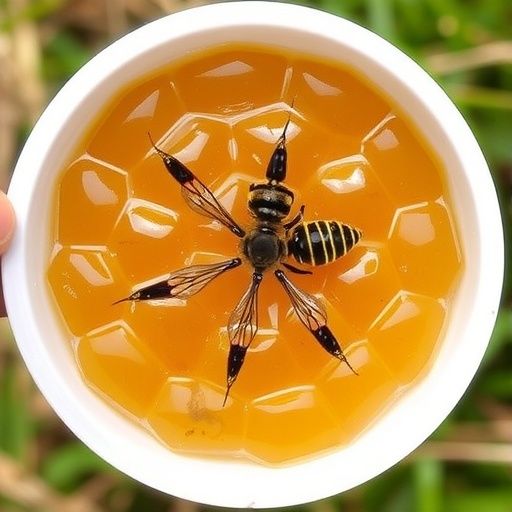In a groundbreaking study poised to transform our understanding of stingless bee honey preservation, researchers have unveiled the intricate effects of thermal treatment on the quality of Tetragonula testaceitarsis honey during room temperature storage. This research not only offers vital insights into how honey’s nutritional and sensory attributes evolve post-thermal processing but also holds profound implications for the apiculture and food biotechnology industries worldwide. The work, conducted by Setiawan, Melia, Juliyarsi, and colleagues, dives deep into the biochemical and physical transformations that occur when stingless bee honey endures heating—an often unavoidable step for sterilization and extending shelf life.
Honey from stingless bees, particularly Tetragonula testaceitarsis, has long been valued for its unique flavor profile, medicinal properties, and complex biochemical composition. Unlike conventional honey, it possesses distinct physicochemical characteristics that contribute both to its premium market appeal and its susceptibility to quality changes under varying storage conditions. The study’s investigative lens on how thermal treatment—a common practice to eliminate microbial contaminants—affects this type of honey during room temperature storage fills a critical gap in apicultural science and food safety.
The researchers embarked on a meticulous evaluation of the honey’s quality parameters following thermal exposure, applying sophisticated analytical techniques to monitor changes in color, pH, moisture content, enzymatic activity, and antioxidant capacity. Thermal treatment, typically conducted at controlled temperatures, is known to influence honey’s enzyme-mediated reactions, impacting both its stability and health benefits. However, the specific repercussions on stingless bee honey, which is chemically and structurally different from other types, remained underexplored until now.
.adsslot_N6GD1vltVk{ width:728px !important; height:90px !important; }
@media (max-width:1199px) { .adsslot_N6GD1vltVk{ width:468px !important; height:60px !important; } }
@media (max-width:767px) { .adsslot_N6GD1vltVk{ width:320px !important; height:50px !important; } }
ADVERTISEMENT
One key component examined was the enzymatic activity, particularly that of diastase and glucose oxidase enzymes, essential for honey’s antimicrobial effects and freshness indication. The researchers observed a notable decline in these enzymes’ activity with increasing thermal stress, highlighting a potential compromise of honey’s natural defense mechanisms. This aspect is especially critical because enzymes contribute to the honey’s ability to inhibit pathogenic bacteria, thereby sustaining its therapeutic credibility.
Colorimetric analysis revealed that thermal treatment induced a darker coloration in the honey samples over time, an effect amplified during room temperature storage. This browning phenomenon, largely attributed to Maillard reactions and caramelization of sugars, serves as a visual indicator of quality deterioration. Such color changes can influence consumer perception adversely, despite not necessarily denoting spoilage. Understanding these aesthetic transformations is vital for producers seeking to maintain marketability without compromising processing standards.
Furthermore, moisture reduction was recorded after heat exposure, a factor that paradoxically could enhance shelf life by lowering water activity conducive to microbial growth. Yet, this moisture loss must be carefully controlled, as excessive dehydration could alter the honey’s texture and sweetness, undermining consumer expectations. The study emphasized the delicate balance required in thermal treatments to prevent detrimental physical changes while achieving microbial safety.
The investigation extended to the honey’s antioxidant properties—a cornerstone of its health claims. Thermal processing appeared to reduce the total phenolic content and antioxidant capacity progressively, a concern since these compounds play a crucial role in neutralizing free radicals. The decline signifies that heat treatment, while sterilizing, may diminish some of the therapeutic benefits naturally present in stingless bee honey, calling for optimized protocols that preserve bioactive compounds.
Additionally, pH values, an indicator of acidity influencing flavor stability and microbial susceptibility, showed minor fluctuations within acceptable thresholds post-thermal treatment. This stability supports the notion that although some biochemical parameters shift, the fundamental acidic nature of stingless bee honey is resilient to moderate heat exposure. Maintaining pH equilibrium is essential for flavor integrity and inhibition of spoilage organisms.
Throughout the study, researchers also documented the honey’s sugar profile alterations, noting subtle rearrangements of fructose and glucose percentages. These sugars’ balance is essential to the sensory attributes and crystallization tendencies of honey. Minor changes could impact texture, potentially affecting shelf appeal, and revealing that thermal effects extend beyond surface-level metamorphoses into the molecular matrix of honey.
Crucially, the kinetics of these quality changes were mapped meticulously, underscoring that room temperature storage amplifies the adverse effects initiated by thermal treatment. This interaction suggests that immediate post-processing handling and storage conditions are pivotal in determining honey’s ultimate quality at the point of consumption. Producers are thus encouraged to consider not only heating regimes but also post-treatment environments to maintain product excellence.
The research methodology combined traditional physicochemical assays with advanced spectroscopic and chromatographic techniques, ensuring a comprehensive assessment of honey’s multifaceted quality dimensions. This integrative approach allowed the team to unravel the complex interplay between heat-induced reactions and storage duration, providing a holistic picture of honey quality dynamics.
From an industrial perspective, this study paves the way for revisiting standard thermal processing procedures applied to stingless bee honey. It advocates for the development of thermally optimized treatments that minimize enzymatic degradation and antioxidant loss while securing microbial safety. Such advancements could enhance product shelf life, consumer satisfaction, and trust in stingless bee honey’s health properties.
Consumers, often attracted to stingless bee honey for its raw and natural essence, stand to benefit indirectly from these findings. By refining thermal processes and storage recommendations, producers can deliver consistently safe, high-quality honey that retains its renowned nutritional and medicinal qualities over time, even at ambient temperatures.
Moreover, the environmental implications are noteworthy. Improved preservation methods could reduce wastage caused by quality deterioration, promoting sustainable utilization of stingless bee honey, which itself represents a vital resource sustaining local ecosystems through pollination.
The study also prompts additional research avenues, particularly exploring alternative non-thermal preservation technologies such as high-pressure processing or pulsed electric fields, which may circumvent the drawbacks of heat while ensuring food safety. Investigations into packaging innovations that stabilize honey post-treatment could complement these efforts, creating a synergistic framework for quality preservation.
In conclusion, this extensive inquiry into the effects of thermal treatment on Tetragonula testaceitarsis stingless bee honey offers invaluable knowledge bridging apicultural tradition and scientific innovation. It portrays a nuanced narrative where the quest for microbial safety intersects with the imperative to maintain honey’s intrinsic properties. These insights herald a future where honey processing and storage are finely tuned to safeguard its heritage and benefits, enhancing its status in the global food and health markets.
Subject of Research: Quality changes in thermally-treated Tetragonula testaceitarsis stingless bee honey during room temperature storage.
Article Title: Quality changes in thermally-treated Tetragonula testaceitarsis stingless bee honey during room temperature storage.
Article References:
Setiawan, R.D., Melia, S., Juliyarsi, I. et al. Quality changes in thermally-treated Tetragonula testaceitarsis stingless bee honey during room temperature storage. Food Sci Biotechnol (2025). https://doi.org/10.1007/s10068-025-01922-y
Image Credits: AI Generated
DOI: https://doi.org/10.1007/s10068-025-01922-y
Tags: apiculture food biotechnologybiochemical transformations in honeyhoney shelf life extensionhoney sterilization methodshoney storage conditionsnutritional attributes of honeyphysicochemical characteristics of stingless bee honeyquality changes in honeysensory attributes of Tetragonula honeystingless bee honey preservationTetragonula honey qualitythermal treatment effects on honey






